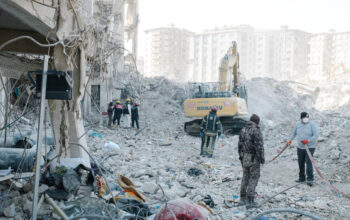
KYIV, Ukraine — Russian forces attacked dozens of Ukrainian positions across the eastern front, the Ukrainian military said on Monday, as Moscow’s assaults widened and intensified ahead of what Kyiv has warned could be the Kremlin’s largest offensive since the first weeks of the war.
The Ukrainian General Staff, which is responsible for military strategy, said in its daily battlefield update that the Russians fired on about two dozen towns and villages around Bakhmut, the ruined city that has become the focal point of Moscow’s campaign to seize all of the eastern area known as the Donbas.
But the general staff said that the chaotic nature of the Russian effort — which included waves of inexperienced recruits and former convicts belonging to the Wagner private military company — was limiting its effectiveness.
“There was a complete lack of coordination and interaction among the servicemen of Russian occupation troops and the so-called Wagner Group’s mercenaries,” it said.
Just as Russia used its overwhelming advantage in artillery early in the war to grind out gains in eastern Ukraine, it is now deploying hundreds of thousands of newly mobilized soldiers, in small groups, to probe for vulnerabilities in Ukrainian defensive lines. That has forced Ukraine to stretch its forces to meet the threat.
But while the fighting has been brutal — with hundreds of soldiers being killed or wounded daily on both sides, according to U.S. and European estimates — neither side has achieved any significant territorial gains in months. The eastern front has remained largely the same, running along a 140-mile stretch of territory that forms the shape of a jagged crescent moon.
The State of the War
- On the Ground: Amid what Ukrainian officials say is the beginning of a new Russian offensive, Kyiv’s troops are under increasing pressure across the eastern front, with fighting particularly fierce around the city of Bakhmut.
- Leadership Shake-Up: President Volodymyr Zelensky’s political party will replace Ukraine’s defense minister, Oleksii Reznikov. The expected move comes amid a widening corruption scandal, although Mr. Reznikov was not implicated in wrongdoing.
- E.U. Visit to Kyiv: European Union leaders met with Mr. Zelensky and vowed to continue supporting his country. But they withheld a prize the Ukrainian president dearly wants: accelerated E.U. membership.
- Nuclear Fears Abate: U.S. policymakers and intelligence analysts are less worried about Russia using nuclear weapons in the war. But the threat could re-emerge, they say.
It remains unclear where and when Moscow will mount a large-scale offensive, but Ukraine’s defense minister, Oleksii Reznikov, said on Sunday that tens of thousands of newly mobilized soldiers had been dispatched to the northeastern and southeastern parts of occupied Ukraine.
He said that Moscow was determined to break through Ukraine’s defensive lines before the anniversary of Russia’s invasion, on Feb. 24. In an effort to damage Moscow’s ability to finance the war, the European Union said recently that it would expand a ban on most crude oil from Russia to include supplies of diesel and gasoline.
To shore up Moscow’s support in other quarters, Russia’s foreign minister, Sergey V. Lavrov, on Monday began his third trip to Africa in about six months.
Mr. Lavrov is beginning his tour in Mali, where he will aim to strengthen defense and security ties, the Malian Foreign Ministry said in a statement. Russia has already supplied Mali with military aircraft including helicopters, as well as hundreds of military advisers and operatives, many of whom Western officials say belong to the Wagner mercenary group.
Before traveling to Mali, Mr. Lavrov visited Iraq on Sunday. He was scheduled to travel next to Mauritania and Sudan, according to the Russian news agency Tass.
While Mr. Lavrov was heading out of Russia, the head of the United Nations’ nuclear watchdog was heading in. He will meet with Russian officials — though not President Vladimir V. Putin — in Moscow this week to discuss security at the occupied Zaporizhzhia Nuclear Power Plant in southern Ukraine, Tass reported.
Rafael Mariano Grossi, the head of the International Atomic Energy Agency, has spent months attempting to broker a deal to create a demilitarized security zone around the nuclear facility, which has been hit by frequent shelling. He met last month with President Volodymyr Zelensky of Ukraine. Last week, Mr. Grossi said that progress on the talks was “too slow and more determined efforts are required from all sides.”
But those matters are a world away from the crescent-shaped eastern front in Ukraine. At the northern edge is the Russian-held city of Kreminna, where heavy battles are playing out in the surrounding forests. Kreminna is where the Ukrainian counteroffensive in September stalled after driving the Russians from the northeastern Kharkiv region, and it is now one of the areas where Ukrainian officials have said Moscow is massing troops for a renewed assault.
At the center of the crescent is Bakhmut, the site of one of the war’s most prolonged and bloody battles, where Russia has made slow progress in its monthslong attempt to encircle the city. Lt. Roman Konon, who is fighting in the city with the “Freedom” battalion of the Ukrainian National Guard, said Russia continued to attack with “an unprecedented force.”
“First, the infantry units of the occupiers go on reconnaissance by combat, then a massive barrage of artillery begins and the infantry assault is repeated again,” he said in a video message played on Ukrainian national television.
Despite Russia’s “minor successes in advancing,” he said, Ukrainian forces still controlled a highway that allowed supplies to get into the city.
At the southern edge of the crescent, near the town of Vuhledar, Ukraine said Russian attacks had been repulsed. But Ukrainian officials warned that tens of thousands of Russian soldiers had been deployed to the region and could be gathering for a more coordinated assault.
President Zelensky said on Sunday night that Russian forces were determined to avenge their setbacks in the first year of the war, and that the “fierce battles” raging on the front would likely grow in intensity.
“We have no alternative but to defend ourselves and win,” he said.
Cassandra Vinograd and Elian Peltier contributed reporting.



